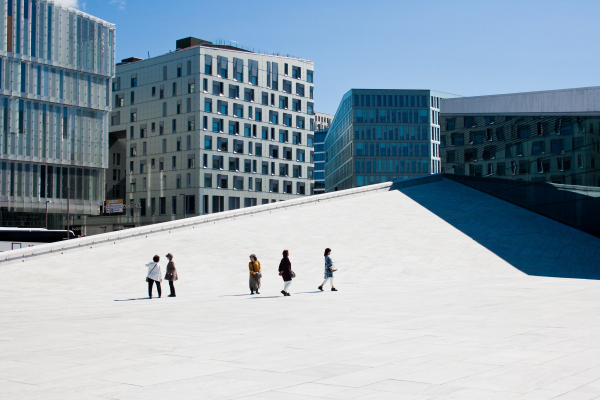Detailed Guide to the Best Places in Oslo, Norway
 We had dreamed of traveling to Norway for a long time, especially after watching Scandinavian detective series and being inspired by Scandinavian influencers. Finally, my dream came true, and here we are in Oslo, setting out to discover Norwegian happiness.
We had dreamed of traveling to Norway for a long time, especially after watching Scandinavian detective series and being inspired by Scandinavian influencers. Finally, my dream came true, and here we are in Oslo, setting out to discover Norwegian happiness.They now call it cutting-edge architecture in Oslo. From the smart renovation of the waterfront to provocative art installations and user-friendly public spaces, Oslo blends the architecture of ancient centuries with ultra-modern districts, seamlessly integrating tradition with modernity.
Planning every detail of our route a month in advance, I feared missing something, but it turned out to be easy and effortless, filled with inspiration at every turn. Embracing spontaneity, I abandoned my meticulous planning in Norway's capital and did not regret it. Hence, I share with you a guide to the top places in lively, stylish Oslo, unlike any other city in the world. Why fly to Oslo?
Talking about Oslo without mentioning the architecture of one of the world's most modern cities is impossible. We visited Oslo in summer, one of the most beautiful times when the city bursts with colors and greenery, while also being amazed by the ongoing construction along the waterfront. Apparently, Norwegians strive to meet the ambitious deadlines set in the Fjord City reconstruction program, which began in 2000 and aims to complete by 2030. This remarkable development plan aims to highlight the beauty of the fjord, transforming it into the city's main landmark. Soon, the waterfront area will be transformed into a pedestrian zone with modern architecture, entertainment infrastructure, green spaces, and most importantly, waterfront access. Oslo's ultra-modern quarters impress with their thoughtful urban planning solutions. The striking combination of glass, steel, and wood embodies the principles of Norwegian design.
Leisure
The capital exudes the pulse and energy of a major city with numerous cafes, markets, and art centers, while also exuding a relaxed atmosphere, surrounded by wild forests and fjords within easy reach. Let me share the places worth seeing. Karl Johans gate is the main pedestrian street in Oslo. It starts right by the station and leads up to the Royal Palace. The street is impeccably maintained, as if ready for a royal visit. With its diversity of colors and flawless classical architecture, Karl Johans gate features numerous iconic historical buildings, including the cathedral, parliament, university, and National Theatre. While the cathedral is a typical Gothic church of the North, the parliament and National Theatre appear more magnificent than many buildings in Scandinavia.
The Royal Palace, constructed in the first half of the 19th century, has a monumental and restrained appearance against the backdrop of the parliament or theatre. While you can't go inside, you can walk around the grounds. By the way, if the flag is raised at the palace, the king is in the country.
The Opera House is the most beautiful building in Oslo for me. Even if you're not a fan of classical music, visiting the opera is worth it just for the building itself. You can also go up to the roof for free and take a walk.
The Norwegian Parliament - Stortinget. It's the highest arena for political debates and decision-making in the Kingdom of Norway. On Saturdays at 10 and 11:30 am, you can take a free English-speaking tour of the parliament, while the rest of the time you can wander around outside and admire the architecture.
City Hall. It's worth a visit for its collection of Soviet-style tapestries and carved wooden paintings depicting Scandinavian mythology. By the way, the legendary Nobel Prize ceremony is held here every year. The Deichman Bjorvika Library. This five-story building with floor-to-ceiling glass windows is a public space housing 450,000 books. A very stylish building that captivates the imagination.
Grunerlokka district. Visit this trendy, youthful neighborhood on a Sunday when the market unfolds, selling everything from food to jewelry. There are also two great places here with very tasty coffee.
Aker Brygge was once industrial, but today it's one of the most elite and stylish neighborhoods in the city, with plenty of restaurants along the waterfront, modern architecture, and sculptures.
Cultural Program
The National Gallery of Oslo. The museum's main pride is, of course, Munch's "The Scream". In addition, you can get a full sense of Norwegian painting and art, as well as admire canvases and sculptural compositions from around the world—works by Monet, Van Gogh, Picasso, Matisse. There are also exhibits from the world of architecture and design. Munch Museum. This was the place I wanted to visit the most. Before his death, Edvard Munch bequeathed all his works to the city, so in 1963, the first museum of the painter appeared, displaying a huge collection of his works, and in 2020, a new one opened, a true masterpiece of modern architecture that transformed the cityscape, offering all admirers of Munch's work to visit virtual tours. The exhibits displayed here are a real discovery for many: Munch created many works besides the world-famous painting "The Scream". You can also satisfy your aesthetic hunger at the Astrup Fearnley Museum of Contemporary Art, which has a significant collection. The building in hi-tech style was designed by Italian architect Renzo Piano (author of the Pompidou Center, Amsterdam's NEMO Museum, etc.). The museum resembles illustrations in magazines about the architecture of the future, which arrived in Oslo a decade ago.
Vigeland Sculpture Park - a huge park with dozens of expressive sculptures by Gustav Vigeland. This is one of the main free entertainments in Oslo: there are over 200 statues here. The task of each monument is to tell about various aspects of human life. Ekeberg Sculpture Park, which houses 31 sculptures. Here you will also find copies of classical sculptures by Salvador Dali, Auguste Rodin, and Auguste Renoir. When we climbed the observation deck in Ekeberg Sculpture Park and saw the entire splendor of Oslo Fjord and the scale of reconstruction - with all its ready-made charms and those just emerging - we were truly amazed. Wishing you the same.









